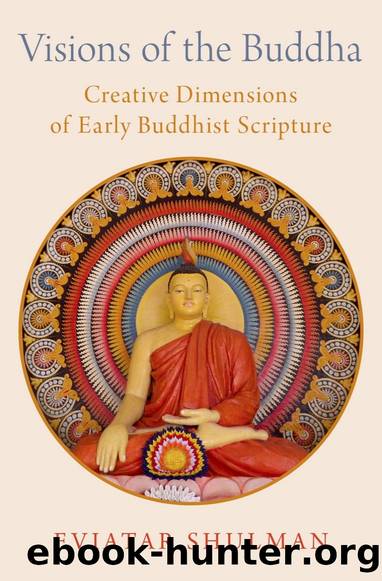Visions of the Buddha: Creative Dimensions of Early Buddhist Scripture by Eviatar Shulman

Author:Eviatar Shulman [Shulman, Eviatar]
Language: eng
Format: epub
ISBN: 9780197587881
Barnesnoble:
Goodreads: 58500934
Publisher: Oxford University Press
Published: 2022-09-15T00:00:00+00:00
Buddhist Fun in the PÄá¹ika-sutta
The PÄá¹ika is framed as an encounter between the Buddha and a wandering recluse (paribbÄjaka) named Bhaggava-gotta, who meet according to a shortened version of the âtoo early for almsâ formula discussed in Chapter 1. Bhaggava questions the Buddha about the Licchavi Sunakkhatta, who has stated that he left the Buddhaâs guidance and no longer lives under his instruction.21 Sunakkhatta, who is known from four different NikÄya discourses, is a key figure in the discourse. If we may judge by the MahÄli-sutta of the DN, he was, at least for some time, a serious practitioner who had significant, if irregular, meditative attainments.22 In the Sunakkhatta-sutta (MN 105) he appears as a student with eager interest in the Buddhaâs guidance and in monksâ meditative attainments. Perhaps, as the commentary to the MahÄsÄ«hanÄda-sutta (MN 12) suggests, he was the son of a prominent Licchavi leader (rÄjaputto). Yet, although it appears that Sunakkhatta was probably not understood by the authors of the discourses to have become a monk, and appears rather as a householder who took a strong interest in the teaching or (more probably) a novice who did not receive full ordination,23 the fact that a person with his social prominence left the Buddhaâs tutelage had to be accounted for. On a certain level, the PÄá¹ika is the rationalization of this event, although it is no less a comedy inspired by his memory.
The Buddha begins his response to Bhaggavaâs inquiry by relating the conversation he held with Sunakkhatta about leaving the order. Sunakkhatta approaches the Buddha and states his intention to leave, to which the Buddha condescendingly replies, âWell, Sunakkhatta, did I ever say to you, âCome live under my instruction?âââ When Sunakkhatta affirms that he had not, the Buddha continues, âThis being the case, foolish man, who then has rejected whom?â24 Sunakkhatta complains that the Buddha did not display any magical powers beyond the human,25 and that he provided no knowledge about the origin of things (aggañña), to which the Buddha responds in similar manner, and added that performing miracles or making the origin of things known would not make a difference to someoneâs ability to practice according to his instruction and to end suffering.26 The Buddha then reminds Sunakkhatta that he had praised the Buddha, dhamma, and saá¹ gha many times among the Vajjians, so his leaving would be interpreted as an inability on his part to perfect the training. With this, âSunakkhatta the son of the LicchavÄ«s left this teaching and training (dhamma-vinaya) like someone headed to misfortune, on his way to hell (apÄyiko, nerayiko).â27
This simple but energetic opening sets the stage for the real life of the discourse, which consists of a series of dramatic episodes in which the Buddha demonstrates his magical power over three naked ascetic (acelo) teachers who impressed Sunakkhatta. The text is somewhat ambiguous as to whether these events took place before or after the teacher and student parted ways, since Sunakkhatta is antagonistic to the Buddha throughout, and each event ends with the formula about Sunakkhatta leaving the order like one destined for hell.
Download
This site does not store any files on its server. We only index and link to content provided by other sites. Please contact the content providers to delete copyright contents if any and email us, we'll remove relevant links or contents immediately.
Technical Art History by Jehane Ragai(387)
Art, Science, and the Natural World in the Ancient Mediterranean, 300 BC to AD 100 by JOSHUA J. THOMAS(367)
Graphic Culture by Lerner Jillian;(362)
The Slavic Myths by Noah Charney(312)
Simply Artificial Intelligence by Dorling Kindersley(293)
Treasuring the Gaze by Hanneke Grootenboer(290)
The Art of Portrait Drawing by Cuong i(282)
Drawing Landscapes by Barrington Barber(279)
Drawing for the Soul by Zoë Ingram(274)
Pollak's Arm by Hans von Trotha(273)
The Art of Painting Sea Life in Watercolor by Maury Aaseng Hailey E. Herrera Louise De Masi and Ronald Pratt(265)
Sketchbook Confidential: Secrets from the private sketches of over 40 master artists by Editors of North Light Books(253)
Portrait of a Woman by Bridget Quinn(250)
Preparing Dinosaurs by Wylie Caitlin Donahue;(241)
A text-book of the history of painting by Van Dyke John Charles 1856-1932(239)
Egyptian art by Jean Capart(238)
Mountain Manâs Field Guide to Grammar by Gary Spina(235)
Anatomy for the Artist by Jennifer Crouch(234)
Botanical Illustration by Valerie Price(231)
